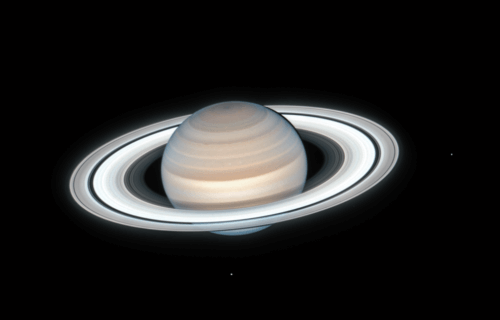GREENBELT, Md. — There’s been a lot of exciting space news recently. The Pentagon is talking about the existence of “off-world vehicles.” NASA discovered a solar system just like ours. And comet NEOWISE is lighting up the night’s sky. If all that isn’t exciting enough, NASA officials are now giving the world an amazing glimpse of the sixth planet, Saturn.
Taken by the Hubble Space Telescope, Saturn’s icy rings are brilliantly visible in the July 4 image. Distinct bands of color can be seen on the planet’s surface. The Hubble photo also captures two of Saturn’s 82 moons. Mimas is seen to the right and Enceladus is at the bottom of the scene over 800 million miles away.
Summertime on Saturn
NASA’s team in Maryland says it’s currently summertime in the planet’s northern hemisphere. Some scientists believe this is the cause of the slight red haze that covers Saturn. Extra heat may be causing increased sunlight exposure to remove icy aerosols from the atmosphere.
It might also be changing the amounts of photochemical haze produced. At the southern pole, Saturn seems to have a blue haze, probably because it’s wintertime down there.
“It’s amazing that even over a few years, we’re seeing seasonal changes on Saturn,” says lead investigator Amy Simon of the Goddard Space Flight Center in a press release.
What are those iconic rings made of?
The authors of the new report also make new observations about Saturn’s famous rings. They believe the rings are mostly chunks of ice that range in size from small grains to large boulders. NASA says it’s unclear how and when the rings of Saturn formed, but that doesn’t keep scientists from offering many different opinions about it.
Some astronomers believe the rings formation dates to when the planet’s birth over four billion years ago. Others speculate the rings are younger since they are so bright. Opponents of this theory don’t see how the vibrant rings could form within the last few hundred million years.
“NASA’s Cassini spacecraft measurements of tiny grains raining into Saturn’s atmosphere suggests the rings can only last for 300 million more years, which is one of the arguments for a young age of the ring system,” says Michael Wong of the University of California, Berkeley.
Hubble has been in space since 1990. Edwin Hubble , the telescope’s namesake, gained fame in the 1920’s for discovering galaxies beyond the Milky Way at his observatory in California.
Like studies? Follow us on Facebook!
